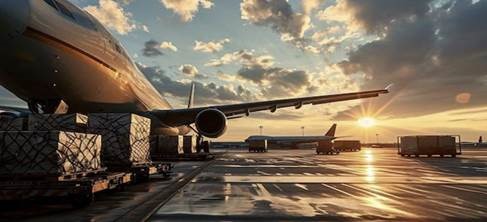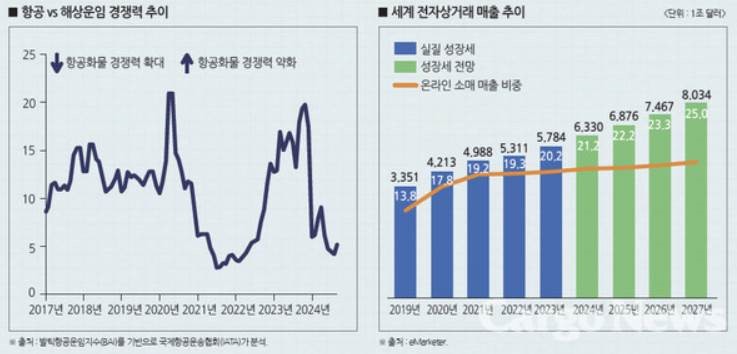엑스트란스 - 항공 물류 업데이트 - 03주차 블로그
항공화물 General
1) 아시아-유럽노선 올해 공급확대 지속

- 새해부터 아시아와 유럽노선에 대한 신규화물 노선이 개설됨. 1월 8일부터 MSC Air Cargo는 암스테르담(AMS)과 인천(ICN) 노선을 운항에 들어가며,이항공사는 현재 ‘B777’ 화물기 5대를 운항 중에 있음. 이가운데 4대는 아틀라스항공(Atlas Air), 1대는 최근합병한 ‘ 알리스카고 항공 (Alis Cargo Airlines)’ 이 운항 중에 있음.
- 해당 서비스는 인천(ICN)과 브뤼셀(BRU) 간 노선을 포함 할 수 있는 에어인천 (Air Incheon)과 경쟁할 가능성.
- DB Schenker도 8일부터 에티하드항공(EY) 화물부문과 파트너십을 통해 중국 어저우 (EHU)와 프랑크푸르트 (FRA) 노선에 정기편 세편을 운항하기 시작했으며, 운항기재는 ‘777F’로 알려짐.
- 매주 화요일 어저우 (EUH)를 출발해 아부다비 (AUH)을 경유하며, 전자상거래를 비롯해 HI-TECH 물동량 등에 대응하기위한 전세편 운항이라고 설명함. 연간 약 5,200톤의 물량을 처리할 것으로 추정됨.
- 추가로, 어저우 (EHU)로 알려진 Ezhou Huahu International Airport은 떠오르는 화물 운송지로, 30개의 국제 화물 노선과 53개의 국내 화물노선을 보유하고 있으며, 작년 중국 내에서 가장 빠른 성장률을 기록해 화물 처리량 120만톤으로 5위를 차지함.
- 우한에서 75km 떨어져 있으며, 장강 삼각주 및 주강 삼각주 지역을 포함한 5대국가급 도시권과 1.5시간 비행거리에 있음.
- Maersk Air Cargo도 중국 정저우(CGO)와 덴마크 빌룬(BLL)노선을 주6편 정기 운항하기 시작했으며, 운항기재는 ‘B767’ 화물기로 전자상거래와 전자제품을 주로 운송함.
- 마지막으로, 노선과는 관련 없지만, 에어 애틀랜타 아이슬란딕(Air Atlanta Icelandic)은네트워크 항공 그룹(Network Aviation Group)을 위해 운항될 예정인 차이나 에어라인 카고(China Airlines Cargo)의 747F 항공기를 인수함.
2) 금년 항공화물 시장 대체로 낙관

- 작년 국제 해상운송의 공급망 혼란으로 항공화물시장은 반대급부로 성장을 이어간 한 해. 국제항공운송협회(IATA)가 지난달 밝힌 '항공화물 운영 - 2025년 전략적 선결 과제 보고서 (Cargo Operations - 2025 Strategic Priorities Report)에 따르면 작년 상반기 세계항공화물 수요(CTK)는 전년동기 대비 13.4%, 공급도 15.6%가 각각 확대한 것으로 분석.
- 이같은 항공화물 수요 증가의 요인은 전자상거래 물동량이 핵심. 협회에 따르면 작년 전자상거래 상품 판매도 전년대비 10~12% 성장한 것으로 분석. 이에따른 작년 세계 전자상거래 시장 규모는 6조 3,000억 달러에 달할 것으로 예상. 국경 간 전자상거래 상품의 80% 이상이 항공운송에 현재 의존 중.
- 작년 전세계 상품 교역량은 전년대비 2.7%, 올해는 3%의 성장세가 각각 예상. 이는 세 계 실질 국내총생산(GDP) 성장률을 약간 넘어선 것.
- 작년 세계 전자상거래 소매 매출은 작년보다 21.2% 성장한 6조 3,300억 달러에 달한 것으 로 분석. 올해는 22.2%, 2026년에도 23.3%의 성장세를 각각 유지할 전망.
- 전자상 거래로 움직이는 실질적인 '소포(parcels)' 물동량도 지난 2022년 1,700억 개로 2014년 대비 4배나 증가. 2023년 기준 소포 물동량은 1,890억 개에 달함.
- 오는 2027년 이같은 소포 물동량은 2,560억 개에 달할 것으로 보임. 이는 2022년 대비 50%나 급증한 것. 이같이 확대되는 항공 수요에 대해 항공업계도 선행적으로 대응해야 한다고 국제 항공운송협회는 밝힘.
3) 방글라데시,다카발 항공화물 운임 – 연말연휴 이후 수요감소와 함께 급락

- 항공화물운임은 휴가시즌이 끝나면서 물동량이 감소함에 따라 전반적으로 하락세를 보이고 있지만, 일부노선에서는 운임이 더 빠르게 하락. .
- 방글라데시, 다카에서 출발하는 미국과 유럽노선의 항공운임은 지난 한달동안 거의 절반으로 떨어졌음. 방글라데시발 유럽행 현물 운임은 약 두달전 1kg당 약 7.00유로/kg에서 현재 3.40~4.00유로/kg로 하락함.
- 방글라데시 다카발 화물수송 용량은 지난달 대비 2.8% 감소했지만, 여전히 작년 12월과 비교하면 방글라데시의 화물용량은 약15% 증가함.
- 미국으로의 화물운임은 현재 1kg당 5.57 달러로, 두달 전 10달러에서 하락했으며, 다카발 일일수요는 약500~600톤 수준.
- 방글라데시 화물 운송업체협회 (BAFFA)의 나시르 아흐메드칸 부회장은 “ 주요 수출목적지로의 수요가 감소하면서 운임이 하락했다 ” 며, “겨울시즌 주문의 대부분이 이미 발송됐고, 주요 목적지에서는 크리스마스 관련 휴일이 아직 진행 중 ”이라고 설명함.
- 항공화물 운임은 항공사의 용량과 화물수요에 따라 달라진다며, 현재 유럽과 미국의 많은 사무실이 아직 문을 열지않아 수요가 감소했고, 이로인해 운임도 하락했다고 덧붙임. 또한, 운임은 화물크기에 따라 달라질 수 있으며, 대량화물을 운송하는 화주에게는 더 낮은운임이 적용될 수 있습니다.” 라고 밝힘.
- 인도의 의류시장 경쟁이 심화되는 상황에서도, 지난해 1월부터 11월까지 방글라데시의 의류수출은 6.23% 증가하여 총377억 1천만달러를 기록함.
- 수출진흥국의 안와르호세인 부회장은 “ 방글라데시의 수출은 매달 증가하고 있으며, 큰 성장을 보이고 있다 ” 며, “ 2024년 7월부터 12월까지 전체수출은 2023년 같은기간 대비 12.84% 증가했다 ” 고 밝힘.
4) 전자상거래 급성장과 인프라 확충으로 남미 항공화물 수요 확대

- 남미지역의 항공화물시장이 최근 빠르게 성장하고 있음. 이는 전자상거래 수요가 급증하며 주요공항과 물류기업들이 인프라 확충에 적극 나서고 있기 때문.
- 브라질과 우루과이 등 주요시장의 변화가 두드러지고 있음. 글로벌 포워더 및 극동지역 물류업계도 이러한 흐름을 주목하고 있음.
- 브라질 리우데자네이루의 조빔국제공항 (RIOgaleao)은 내년초 글로벌 전자상거래 대기업의 입점을 준비하며 1,000평방미터 규모의 창고를 마련하고 있음.
- 추가수요를 대비해 인근창고를 리모델링하는 작업도 진행 중임.
- 우루과이 몬테비데오의 까라스코 국제공항(LACC)은 올해 초 Temu 플랫폼의 진출로 물량이 예상보다 크게 증가하며 어려움을 겪었음. 하지만, 전자상거래 플랫폼들과의 협력을 통해 인프라를 강화하고있음. 내년 초부터는 구여객터미널을 화물시설로 전환하는 프로젝트를 시작할 예정임.
- 항공사들 역시 대응에 나서고 있음. 전자상거래와 항공화물 수요가 증가하는 상황에서, 카타르항공, 마틴에어, 카고룩스 등 주요 항공사들은 화물기를 아시아 시장으로 재배치하고 있음.
- 이로인해 LATAM Cargo와 같은 현지항공사들이 남미내 수요를 충족하며 공백을 메우고 있음.
- LATAM Cargo는 브뤼셀을 유럽 허브로 지정하고 주당 12회 화물기를 운항하며 시장점유율을 확대하고 있음.
- 터키항공은 이스탄불에서 마이애미를 거쳐 남미로 연결하는 새로운 노선을 개설하며, 아비앙카와의 협력을 강화하고 있음.
- 남미화물시장은 전자상거래 뿐만 아니라 제약, 자동차부품, 농산물 등의 수요가 안정적으로 유지되고 있음.
- 우루과이 몬테비데오의 까라스코 국제공항 (LACC)은 GSK와 협력해 백신을 브라질과 칠레로 공급하는 물류허브로 성장 중이며, 브라질 리우데자네이루의 조빔국제공항 (RIOgaleao)은 GE Aerospace의 엔진 정비 시설로 인해 항공기 엔진 및 부품 물량이 전년대비 21% 증가함.
- 글로벌포워더들은 남미시장의 급성장세에 주목하며 현지 투자진출을 서두르고 있음. 운임상승과 전자상거래 수요 급등, 그리고 기존 제약 및 농산물 물류서비스 허브화 전략이 실효성을 발휘할 것으로 기대되고 있음.
- 중남미 시장은 이제 단순한 성장잠재력을 넘어 새로운 성장 동력을 제공하는 시장으로 자리잡고 있다. 과거 베트남과 인도시장이 그랬던 것처럼, 포워더들 역시 보다 적극적인 전략을 마련할 시점이다.이라고 강조함.

top



